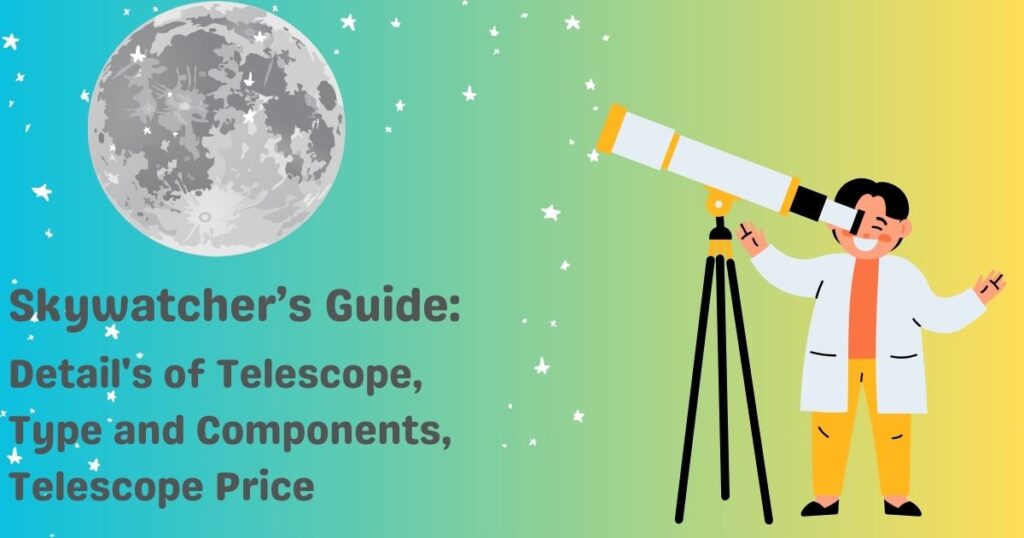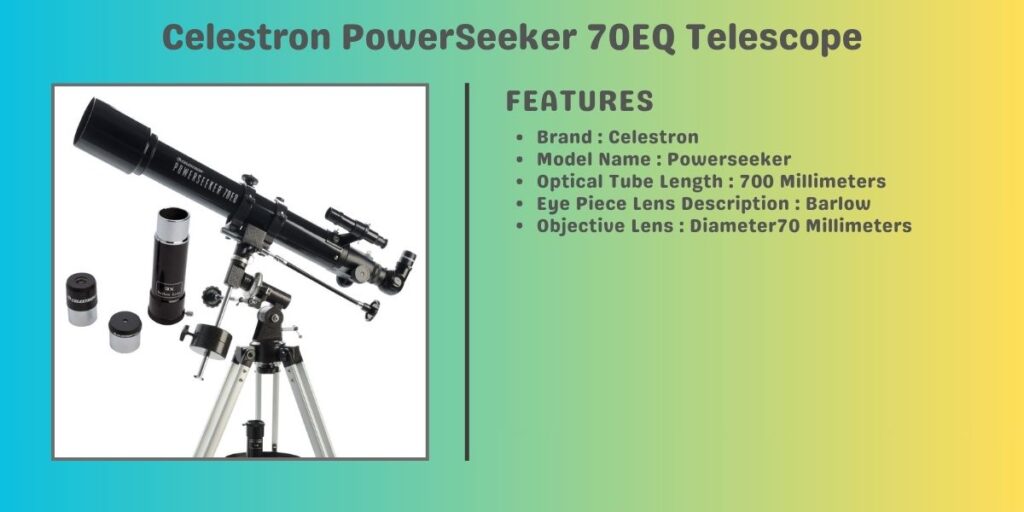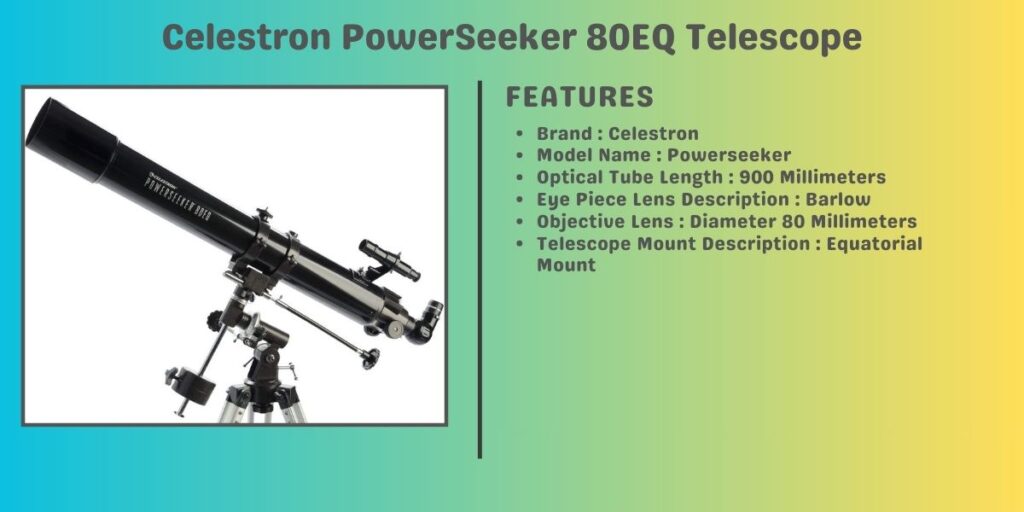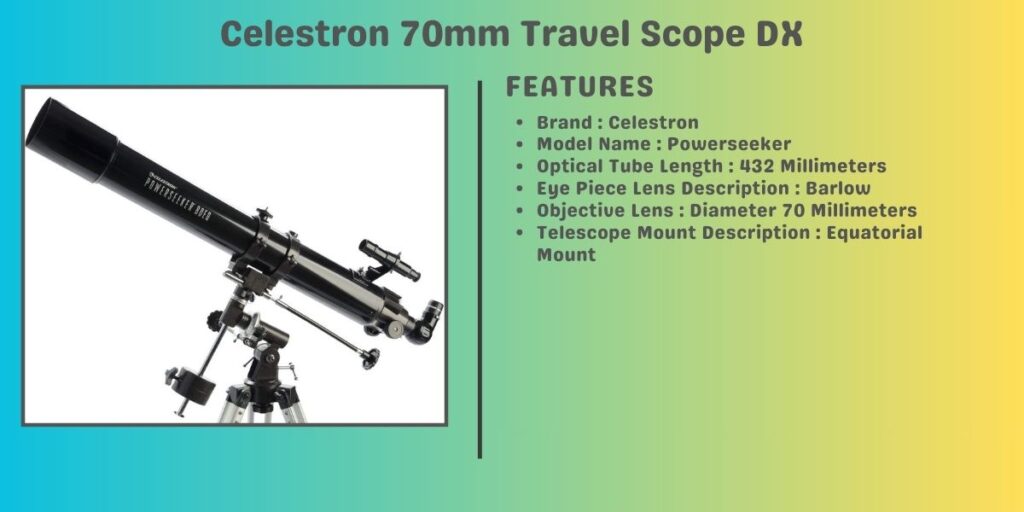Telescopes are amazing visual instruments, with the help of telescope secrets of the cosmos have been revealed. With the help of a telescope we are able to see the vastness of the cosmos. Telescopes have played a vital role in expanding our knowledge of the celestial world.
In this article we will provide information about types of telescope, components of telescope and I have listed here top 3 telescopes for beginners and you can check the telescope price also.
You May Like : Exploring the Cosmos: A Comprehensive Technical Overview Of Refractor Telescopes
Post Contents
Types of Telescopes
Refracting Telescopes (Refractors)
- Overview:
In case of Refracting telescopes lenses are used to collect and focus the light. This type of telescopes have an iconic design, with a long tube and a convex objective lens at the front, basically it is used for stargazing. - Use:
Planetary Observation:
With the help of a refracting telescope, the planets in the planetary system can be visible clearly, we can see scenes like the cloud bands of Jupiter and the rings of Saturn.
It is used to view complex features of the Moon’s surface.
Reflecting Telescopes (Reflectors)
- Overview:
In case of Reflector telescopes mirrors are used to collect and reflect light. The primary mirror captures the incoming light and passes it to the secondary mirror, which then passes it to the eyepiece. The primary mirror is often parabolic in shape. - Use:
Deep-Sky Observation:
Reflector telescopes are used to discover faint and distant objects such as galaxies, nebulae and star clusters. Due to their larger aperture they become powerful instruments by capturing more light.
Astrophotography:
Reflectors are widely used for astrophotography due to their ability to gather light effectively. They are popular choices for capturing detailed images of celestial wonders.
Compound Telescopes (Catadioptric Telescopes)
- Overview:
In case of Compound telescopes both mirror and lenses are used , due to this it provides the advantages of both refractor telescope and reflector telescope. - Use:
Versatility:
Compound telescopes are versatile and suitable for various types of observation, making them popular choices for amateur astronomers seeking a well-rounded instrument.
Portability:
Their compact design and portability make them convenient for stargazing sessions in different locations.
Dobsonian Telescopes
- Overview:
Dobsonian telescopes are a type of reflecting telescope known for their simplicity and large apertures. They consist of a primary mirror on a simple, sturdy mount. - Uses:
Amateur Astronomy:
Dobsonians are often favored by amateur astronomers for their ease of use and affordability. They provide impressive views of a wide range of celestial objects.
Deep-Sky Exploration:
With larger apertures, Dobsonian telescopes are excellent for observing faint deep-sky objects beyond our solar system.
Component of Telescope
Objective Lens :
The objective lens is a large, convex lens used at the front of the telescope. It gathers and refracts the light to bring it to a focus point.
Primary Mirror :
The primary mirror is a curved, usually parabolic mirror. This is located at the bottom of the telescope tube. It reflects and gathers light, directing it to the secondary mirror.
Secondary Mirror :
Secondary mirror is located in front of the primary mirror. It reflects the focused light to the eyepiece.
Eyepiece :
The eyepiece is the location from which an observer is able to view the magnified image. It further magnifies the focused light produced by the objective lens or primary mirror. Different eyepieces provide varying levels of magnification, allowing observers to adjust the telescope’s view based on their preferences and the nature of the celestial object being observed.
Focuser :
The focuser allows the observer to adjust the position of the eyepiece, and helps to tune the focus of the telescope. Some telescopes have manual focusers, while others may have electronic focus controls.
Mount :
The mount is used to provide support for the telescope, it provides stability and allows for adjustments in both altitude (up and down) and azimuth (left and right). There are two types of mounts: alt-azimuth (up-down, left-right) and equatorial (aligned with Earth’s rotation).
Tube or Optical Tube Assembly (OTA) :
The tube holds the components of the telescope. It protects the mirrors or lenses from dust, moisture, and other environmental factors.
Finderscope :
The finderscope is a small, low-powered telescope or sight which is attached to the main telescope. It helps to locate celestial objects by providing a wider field of view, making it easier to center objects before observing through the main telescope.
Aperture :
The diameter of the objective lens or primary mirror is known as aperture. It determines the amount of light that a telescope can gather. Larger apertures allow for better resolution and visibility of faint objects.
Mounting Accessories :
Telescopes may include additional accessories such as counterweights (to balance the telescope), slow-motion controls (for precise adjustments), and GoTo systems (computerized mounts that can automatically locate and track celestial objects).
Tripod (for Portable Telescopes) :
Portable telescopes often come with tripods to provide a stable base. Tripods are essential for terrestrial observations or when stargazing away from a fixed observatory.
Top 3 Telescope For Beginners
Starting your journey to observe stars? With this carefully chosen collection, learn which telescopic companions are ideal for beginners. These telescopes encourage novices to discover the wonders of the night sky since they were carefully selected for their remarkable performance and ease of use. These devices, which are made to make celestial gazing accessible, provide a smooth transition into the fascinating field of astronomy. With confidence, select a telescope from our selection and aim your sights toward the cosmos. All three are refractor telescopes.
Celestron PowerSeeker 70EQ Telescope
Build and Design (4.5/5) :
The Celestron PowerSeeker 70EQ impresses with its sturdy construction and thoughtful design. The equatorial mount adds a professional touch, providing precise tracking of celestial objects. With the weight of 6.30 kg, this telescope makes a balance between stability and portability. The assembly process is straightforward, and the included accessories complement the overall design.
Optical Performance (4.5/5) :
With the help of 70mm aperture, this telescope delivers good optical performance. This telescope provides clear and detailed views of the moon, planets, and other celestial objects. The equatorial mount enhances stability during observations, allowing for smooth tracking and adjustments. At higher magnifications, there is a slight hint of chromatic aberration, but this is a minor trade-off considering the telescope’s affordability in its category.
Ease of Use (4.5/5) :
As per design perspective this telescope is good for beginners and intermediate users. The equatorial mount may require a short learning curve for beginners, but its benefits in tracking celestial objects outweigh this initial challenge. The included accessories, such as the finderscope and eyepieces, enhance the overall ease of use, making it a versatile and accessible telescope for various skill levels.
Portability and Storage (4/5) :
While not the most compact telescope, the PowerSeeker 70EQ remains portable enough for astronomers on the move. The equatorial mount adds to its overall weight, affecting portability to some extent. However, the telescope’s performance justifies the trade-off, and it is still manageable for those seeking a balance between size and capability. A more robust carrying case could further enhance its portability.
Value for Money (4.5/5) :
The Celestron PowerSeeker 70EQ provides excellent value for its price. Offering a solid combination of build quality, optical performance, and user-friendly features, it stands out in its category. The equatorial mount adds a level of sophistication not commonly found in telescopes at this price point. For both beginners and intermediate astronomers, the PowerSeeker 70EQ offers an impressive balance of affordability and performance.
- Sturdy build and thoughtful design.
- Equatorial mount for precise tracking.
- Impressive 70mm aperture for clear views.
- User-friendly for beginners and intermediate users.
- Excellent value for money in its category.
- Some plastic components affect the overall feel.
- Slight chromatic aberration at higher magnifications.
- Equatorial mount adds weight, affecting portability.
Conclusion :
The Celestron PowerSeeker 70EQ Telescope is a noteworthy instrument that exceeds expectations in its price range. With a solid build, impressive optical capabilities, and user-friendly features, it caters to both beginners and intermediate astronomers. While there are minor areas for improvement, the PowerSeeker 70EQ earns its 4.5-star rating as a telescope that offers a compelling blend of affordability and performance.
Overall Rating :
Celestron PowerSeeker 80EQ Telescope
Build and Design (4.5/5) :
The Celestron PowerSeeker 80EQ impresses with its robust build and thoughtful design. Weighing in at a manageable 7.43 kg, it strikes a balance between stability and portability. The equatorial mount provides a level of sophistication, providing precise tracking of celestial objects. The setup process is easy, making it suitable for both beginners and intermediate. While some plastic components are noticeable, they do not compromise the telescope’s overall durability and functionality.
Optical Performance (4.5/5) :
With aperture of 80mm , the PowerSeeker 80EQ offers impressive optical performance. The telescope delivers clear and detailed views of the moon, planets, and other celestial wonders. The equatorial mount enhances stability during observations, allowing for smooth tracking and adjustments.
Ease of Use (4.5/5) :
Designed with both beginners and intermediate users in mind, the PowerSeeker 80EQ offers a user-friendly experience. The equatorial mount, while introducing a learning curve for newcomers, proves valuable for more advanced observations. The included accessories, such as the finderscope and eyepieces, enhance the overall ease of use, making it a versatile telescope for various skill levels.
Portability and Storage (4/5) :
While not the most compact telescope, the PowerSeeker 80EQ remains portable enough for astronomers on the move. The equatorial mount adds to its overall weight, affecting portability to some extent. However, the telescope’s performance justifies the trade-off, and it is still manageable for those seeking a balance between size and capability. A more robust carrying case could further enhance its portability.
Value for Money (4.5/5) :
The Celestron PowerSeeker 80EQ provides excellent value for its price. Offering a solid combination of build quality, optical performance, and user-friendly features, it stands out in its category. The equatorial mount adds a level of sophistication not commonly found in telescopes at this price point. For both beginners and intermediate astronomers, the PowerSeeker 80EQ offers an impressive balance of affordability and performance.
Pros:
- Sturdy build and thoughtful design.
- Equatorial mount for precise tracking.
- Impressive 80mm aperture for clear views.
- User-friendly for beginners and intermediate users.
- Excellent value for money in its category.
- Some plastic components affect the overall feel.
- Slight chromatic aberration at higher magnifications.
- Equatorial mount adds weight, affecting portability.
Conclusion :
The Celestron PowerSeeker 80EQ Telescope is a standout instrument that exceeds expectations in its price range. With a solid build, impressive optical capabilities, and user-friendly features, it caters to both beginners and intermediate astronomers. While there are minor areas for improvement, the PowerSeeker 80EQ earns its 4.5-star rating as a telescope that offers a compelling blend of affordability and performance.
Overall Rating :
Celestron 70mm Travel Scope DX
Build and Design (4.5/5) :
The Celestron 70mm Travel Scope DX stands out with its compact and well-thought-out design. Weight of this telescope is 1.49 kg , it’s an ideal travel companion for on-the-go stargazers. The telescope’s build is surprisingly good for its size, and the quality of materials provide confidence. We can make this telescope setup easily , such a design makes it suitable for beginners and travelers. While the plastic components give a lightweight feel, they do not compromise the telescope’s overall construction.
Optical Performance (4.5/5) :
Equipped with a 70mm aperture, the Travel Scope DX delivers admirable optical performance. The telescope provides clear and detailed views of the moon, planets, and other celestial wonders. The included eyepieces offer versatility, allowing users to tailor their observations to specific targets.
Ease of Use (4.5/5) :
Designed with simplicity in mind, the Travel Scope DX is incredibly user-friendly. The altazimuth mount ensures smooth and intuitive movements, making it easy for beginners to navigate the night sky. The accessory tray adds convenience, providing a dedicated space for eyepieces and other small items. With minimal adjustments needed, this telescope is perfect for spontaneous stargazing sessions.
Portability and Storage (4.5/5) :
True to its name, the Travel Scope DX is a portable marvel. The included backpack makes transportation a breeze, allowing users to take their telescope on camping trips or stargazing expeditions. Its lightweight construction and compact design make it a suitable choice for those with limited storage space. While not the most powerful telescope, its portability makes it an excellent companion for casual astronomers.
Value for Money (4.5/5) :
The Celestron 70mm Travel Scope DX offers exceptional value for its price. Balancing performance with portability, it caters to both beginners and seasoned astronomers looking for a grab-and-go telescope. The inclusion of a backpack and the overall quality of construction make it a worthwhile investment for those prioritizing convenience without sacrificing optical quality.
Pros:
- Compact and portable design.
- Sturdy construction for a travel telescope.
- Provide detailed views with a 70mm aperture.
- User-friendly for beginners.
- Excellent value for money with included backpack.
Cons:
- Plastic components may give a lightweight feel.
- Slight chromatic aberration at higher magnifications.
- Limited power compared to larger, non-portable telescopes.
Conclusion :
The Celestron 70mm Travel Scope DX is a stellar choice for those who crave both portability and performance. With its compact design, admirable optical capabilities, and user-friendly features, it stands as an excellent travel companion for stargazers on the move. While there are minor areas for improvement, the Travel Scope DX earns its 4.5-star rating as a versatile and convenient telescope for both beginners and seasoned enthusiasts.
Overall Rating :




